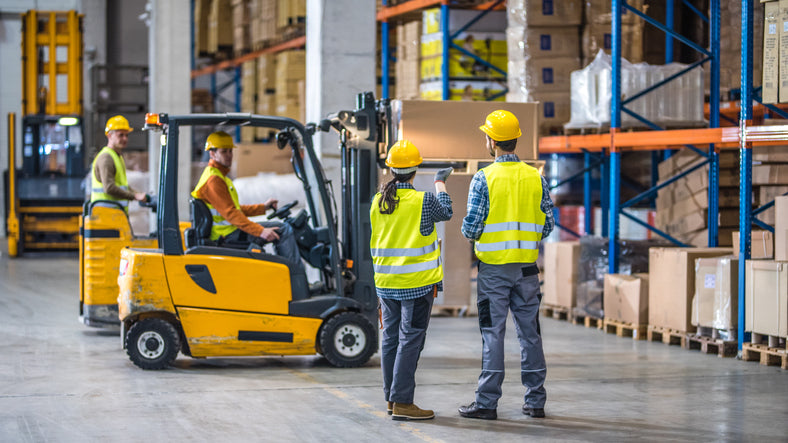0300 303 2549
0300 303 2549

When a warehouse runs efficiently, staff are happier, customers are happier and the company works better as a whole.
Even when a warehouse is working well, there will still always be shifts within the operations that can improve its overall performance. Warehouses are complex operations with many moving parts and functions happening simultaneously, which means there are any number of activities which can be streamlined.
Advances in technology, along with sophisticated management systems and better manual handling equipment can all contribute to an effective operation. Take a look at your current processes and any concerns you may have, and make decisions and investments to improve your productivity.
At BlueTrolley we have been designing and manufacturing exceptional manual handling solutions for more than a decade. Our expert team would love to help you improve your warehouse’s efficiency; get in touch with one of our experts today to find out more.
At first glance, efficiency can seem like an intangible concept; something that can’t easily be measured. At BlueTrolley we know it can be, and it’s vital to help you see where you could be doing better. Our experts have put some tips together to help you start measuring.

Receiving efficiency
This helps you determine how well your receiving area is performing. It can be measured by the volume of inventory received, divided by the number of hours worked. Let’s use an example: you have received 1000 goods in a week, and you have two employees who each work 40 hours. So the sum this time would be 1000 divided by 80, which is 12.5 products processed per hour.
Cost of carrying inventory
This will tell you how much it costs to keep and store your inventory. To do this, calculate your carrying costs and divide that by the overall cost of the inventory.
Receiving cycle time
This measurement will help you determine how long it takes your team to process the goods you receive into your warehouses. This includes everything from unloading, counting, booking the items, and storage preparation. The equation is worked out by dividing the total time of the deliveries by the total number of deliveries.
Every warehouse can improve its efficiency. Once you start measuring, you will soon be able to identify trends and areas of improvement. Here are some suggestions from the experts at BlueTrolley.

1. Improve the layout to optimise storage space
Think about it - are you using the warehouse space you have as effectively as possible? What about the vertical space? Using taller storage units can help you keep more stock in a smaller space, rather than going ahead and taking up a lease on a bigger property.
It will also benefit you to think about the storage units you already have. Are they right for the kind of items you store? Using different shelves for products of different sizes will help make real use of the space.
2. Streamline your inventory
Are there products gathering dust in your warehouse? Adopt a ‘lean inventory’ approach, AKA only store what you actually need, and nothing more. Be sure to work out how your inventory flows in your workspace so you can see what you do and don’t need. Another tip is to ask suppliers to deliver small orders more frequently.

3. Organise work stations
Each worker should be able to find their tools at their warehouse workstations quickly and efficiently. One way to do that is by following the ‘5S’ methodology:
4. Use technology to your advantage
Work smarter, not harder. Utilise a technology system that can suggest the best picking and packing methods and routes. These systems can also be used to send pick lists and other instructions to mobile devices, helping eliminate human error and reduce wasted paper.

5. Simplify your processes
If you don’t have an electronic warehouse management system, there’s no reason why you can’t create your own. Store high value, often-used items at the entrance of your space, and items that are frequently sold or used together next to each other. These small actions once combined, will streamline the running of your business, as well as making your team’s working lives easier and more efficient.
6. Using the right equipment
Having the right kind of equipment in your warehouse will help maximise your team’s productivity. There are a number of things to consider when thinking about the equipment you are using.

7. Staff training
Training can massively increase the overall productivity of your warehouse. Not only does training them help use the equipment in a safer manner, therefore minimising accidents, there are a number of other benefits.

They will be able to complete more tasks (for example, picking and packing certain amounts of orders) in a shorter period of time. This maximises your warehouse employee ROI: the wage you pay each employee. Customer satisfaction is also likely to increase, as your goods or services are delivered in a swift and efficient manner.
We have been creating incredible warehouse solutions since 1995, so it’s safe to say that we know what we are doing. Our experts are equipped with the skills and knowledge to help you improve your warehouse’s efficiency, get in touch to speak to a member of our team.
We are entirely based in the UK, from the parts and materials we source right down to our South Wales workshop. This means not only can we offer an extremely fair price to our customers, but there are also no costly delays waiting for deliveries from overseas.